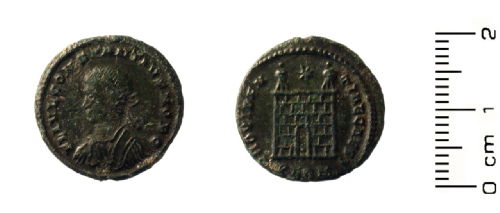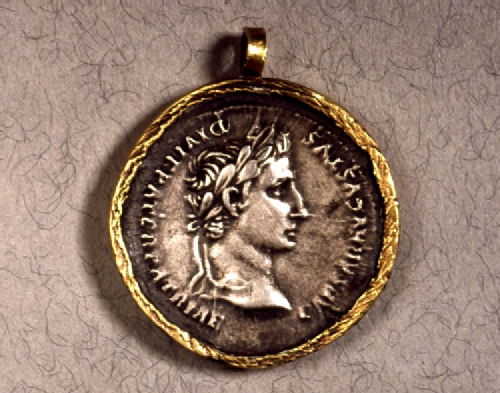All 2 entries tagged Constantine
No other Warwick Blogs use the tag Constantine on entries | View entries tagged Constantine at Technorati | There are no images tagged Constantine on this blog
November 25, 2014
Coining in Roman Britain Part 5: Constantine and the London Mint
Diocletian and the ‘Tetrarchy’ continued to strike coins in London after the fall of Allectus. These coins came in the form of bronze nummi, which formed part of Diocletian’s reformed currency system. They were struck pretty much uniformly across the empire, featured stylized portraits, indistinguishable from one another, and likely bore virtually no resemblance to the rulers themselves.

Copper-alloy nummus of Constantine I from the London mint (note the mint-mark PLN).
The reverse depicts Sol standing left holding a globe, surrounded by the inscription SOLI INVICTO COMITI.
Image: Portable Antiquities Scheme, Unique ID: WILT-78C118
After Constantine was declared emperor by the army in Eboracum (modern day York) in AD 306, the London mint began producing coins showing his portrait. Though Constantine would famously convert to Christianity, these early depictions tended to feature his portrait juxtaposed with depictions of the sun god. Sol, a pagan deity, was associated with invincibility and victory, ideal traits for an emperor to associate himself with. In the early years of his reign Constantine also struck in the Gallic and German cities of Lyons and Trier. After Constantine had taken Rome from the emperor Maxentius, all mints across the empire struck coins for him and his family. The House of Constantine coinages are some of the most common found in Britain today, and feature the emperor himself, as well as his sons and extended family.
 |
 |
Copper-alloy nummi of the London mint. A coin of Crispus (left) displays a globe on an altar and an issue of Constantius II (right) depicts a camp gate with two turrets. Coins such as these are common finds in Britain. Image: Portable Antiquities Scheme, Unique ID: DUR-E3ADF4, HESH-B1C990
The coinage of Constantine’s family comprise small bronze coins with simple designs. Coin types depicting inscribed altars, camp-gates and votive wreaths were struck at London until around the year AD 326. The reason for the London mint’s closure is unknown. It was certainly one of the smallest mints in the empire at this time, operating with only one officina or mint workshop (the ‘P’ in the mint mark), compared to the three at Trier and two at Lyons. Following the closure of the mint at London, later coin types are imitated in large numbers for decades. This may indicate a lack of fresh coin reaching Britain due to the lack of a mint on the island.

This month's coin series on Roman Britain is written by Dom Chorney, a young numismatist from Glastonbury, Somerset. He studied for his undergraduate degree at Cardiff (in archaeology), and achieved a 2:1. Dom is currently studying for an MA in Ancient Visual and Material Culture at the University of Warwick, and intends to undertake a doctorate in 2015. His main areas of interest are coin use in later Roman Britain, counterfeiting in antiquity, coins as site-finds, and the coinage of the Gallic Empire.
August 01, 2014
The Emperor on a chain: Fashionable coins and questions of personal taste
 |
| Coin of Constantine used as a pendant |
This coin of Constantine dates from AD 330-331. It is typical of its type. The obverse displays an image of Constantine whilst the reverse praises the might of the Roman army; two soldiers holding spears flank military standards with the legend ‘GLORIA EXERCITVS’. The modern transformation of this particular coin into a piece of jewellery is not without its ancient precedent, and this has prompted me to investigate the afterlife of coinage in the Roman world.
It is widely accepted that coins are not simply important for their monetary value. To historians studying numismatics their imagery and legends provide evidence for things as diverse as architectural styles to hairstyles. Similarly, at the time of minting, coins held a value which extended further than what they could buy. The way that coins were used outside of the context of financial transactions can teach us valuable lessons about Roman society.
In Petronius’ Satyricon, the character Trimalchio is described as playing a board game with gold and silver denarii instead of the standard black and white counters. Trimalchio is more of a caricature than a character, so we should take scenes like this with a pinch of salt, but the author is here making a point about how the attitude of an individual towards coinage projects a social statement about their personal wealth. Trimalchio’s self-display tells his guests that he can, quite frankly, afford to play with his money. This can be extended to help us to understand why incorporating coinage into jewellery was a way of displaying your wealth and social status.
 |
|
Coin of Augustus used as a pendant © The Trustees of the British Museum |
But self-display was not the sole reason why an individual would choose to transform coins into jewellery. Nor can it simply be explained as a fashion, since fashions change and our evidence for coin pendants spans hundreds of years. A study of the iconography of the coins chosen for this purpose suggests that not just any coin would do. Generally our examples are drilled to allow a chain to pass through, or else a loop attached, and the location of this tells us which way the coin was intended to hang. In most cases the coin was orientated to display the obverse, most tellingly, the image of the emperor. For example, the coin pictured here is orientated to display the diademed profile of Augustus. This coin was minted in 2 BC and its use here celebrates the reign of Augustus. Thus one could argue that coin pendants projected a political as well as social message. The modern day transformation of the ‘Gloria Exercitvs’ coin follows this ancient precedent, but this time the choice was motivated by aesthetic value rather than a desire to make a political statement of allegiance to the emperor.
It is debatable whether the Roman jeweller was motivated by the aesthetic, political or social potential of coinage when they set about incorporating coins into jewellery. Clearly, these artefacts pose questions about the nature of Roman society and the nature of its value system; and since coin pendants remain popular today we could trick ourselves into believing that we are not so different from the Romans after all.
 This month's coin was chosen by Eve Bayram. Eve graduated from Warwick in 2014 with a degree in Classical Civilisation. While at Warwick Eve focused on the study of Latin literature, and her disseration was entitled 'Self-presentation in the Latin epistolary genre: Cicero, Seneca, Petrarch.' She is currently interning in the dictionaries department at Oxford University Press.
This month's coin was chosen by Eve Bayram. Eve graduated from Warwick in 2014 with a degree in Classical Civilisation. While at Warwick Eve focused on the study of Latin literature, and her disseration was entitled 'Self-presentation in the Latin epistolary genre: Cicero, Seneca, Petrarch.' She is currently interning in the dictionaries department at Oxford University Press.
 Clare Rowan
Clare Rowan

 Please wait - comments are loading
Please wait - comments are loading

 Loading…
Loading…

